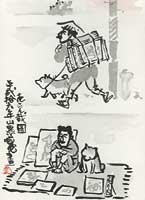|
|
|||||||
|
|
|||||||
|
|||||||
| | Web Japan >> | Trends in Japan >> | Arts & Entertainment >> | A Fresh Look at Traditional Art | |
|
A FRESH LOOK AT TRADITIONAL ART Modern Artists Reinterpret Ancient Forms (January 19, 2005) Tenmyouya Hisashi is one of a group of young and highly acclaimed Japanese artists who borrow styles and ideas from Japan's artistic history, usually juxtaposing ancient motifs with contemporary themes and subjects. Before he became an artist, Tenmyouya was an artistic director for a record company. His art resembles the sampling of various genres of music that characterizes hip-hop, of which he was a devotee in his teens. "Visual Sampling" Another artist, Yamaguchi Akira, 35, renders machines, such as battlefield tanks or motorcycles, in the traditional style of ancient Japanese scrolls that depict battles or tapestries that feature life in historic Kyoto. Yamaguchi first encountered ancient Japanese paintings and drawings while studying oil painting in school. Traditional composition techniques have been a huge influence on his work ever since. In a similar vein, the works of Aida Makoto, 39, also contain styles based on traditional Japanese art and on the depiction of combat in ancient folding screens. The pioneer among this group of young artists is Murakami Takashi. While a student at the Tokyo National University of Fine Arts and Music, Murakami studied Japanese drawing and painting. With the Japanese master painters Ito Jakuchu and Soga Shohaku as his main influences, he went on to create characters for anime and video games. His works quickly grabbed attention in the West, while he was developing an academic approach to his art. Employing a two-dimensional Japanese composition technique called "superflat," he established a new artistic concept characterized by its unbroken links to Japanese art, anything from ukiyo-e to anime. Murakami became a sensation within the art world. His works were the subject of solo exhibitions in famous galleries in the United States and Europe, and some of them fetched extremely high prices at auction houses in the West. He also worked with French fashion house Louis Vuitton to design a hit line of handbags. Reexamining Traditional Art This is an approach that has gained a great deal of international acclaim, and all of these artists have been invited to show their work at leading galleries in the United States and Europe. In contrast to the Japanese art world of the recent past, which largely drew inspiration from the West, these artists have given birth to a new homegrown genre of art that is rich in originality. Copyright (c) 2005 Web Japan. Edited by Japan Echo Inc. based on domestic Japanese news sources. Articles presented here are offered for reference purposes and do not necessarily represent the policy or views of the Japanese Government. |
TEMPLE TREASURES (September 22, 2003) TRIUMPHANT HOMECOMING (March 15, 2002) TAKING THE ART WORLD BY STORM (February 27, 2001) |
|
|



